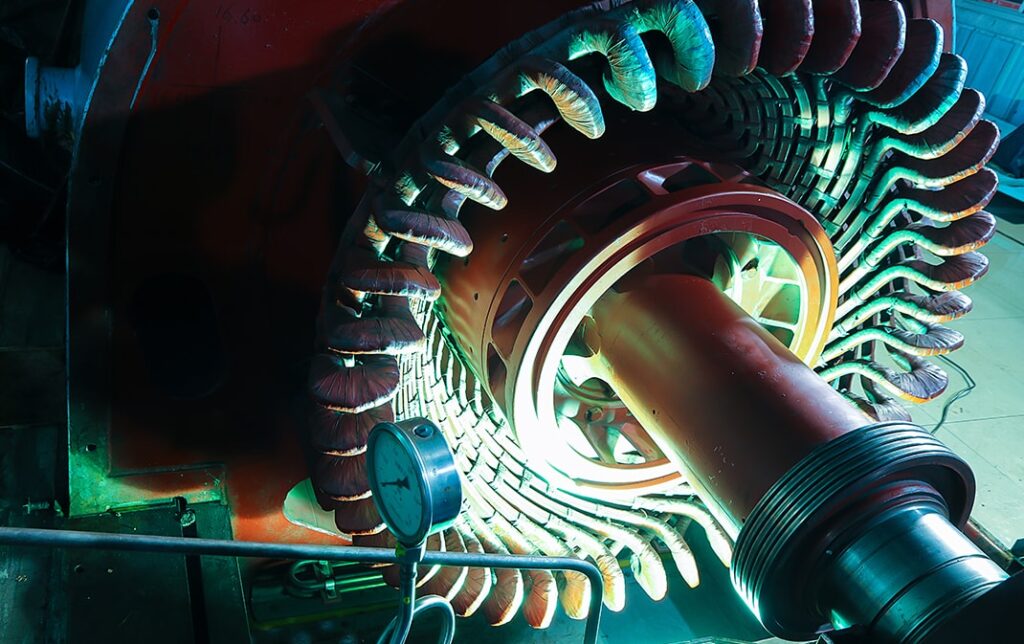Alternator
A synchronous machine used to convert mechanical power into alternating current electric power.
Ambient Temperature
The temperature of the surrounding cooling medium. Commonly known as room temperature when the air is the cooling medium in contact with the equipment.
Base Line
A vibration reading taken when a machine is in good operating condition used as a reference for monitoring and analysis.
Breakdown Torque
The maximum torque an A/C motor will develop with rated voltage applied at rated frequency without an abrupt drop in speed. Also termed pullout torque or maximum torque.
Code Letter
A letter, which appears on the nameplates of A/C motors, to show their locked-rotor kilovolt amperes per horsepower at rated voltage and frequency.
Constant Horsepower
A term used to describe a multi-speed motor in which the rated horsepower is the same for all operating speeds. When applied to a solid-state drive unit, the term refers to the ability to deliver constant horsepower over a predetermined speed range.
Constant Torque Motor
A multi-speed motor for which the rated horsepower varies in direct ratio to the synchronous speeds. The output torque is essentially the same at all speeds.
Delta Connection
A three–phase winding connection in which the phases are connected in series to form a closed circuit.
Design
NEMA design letters A, B, C, D, and E define certain starting and running characteristics of polyphase squirrel-care induction motors. These characteristics include locked-rotor torque, locked-rotor current, pull-up torque, breakdown torque, slip at the rated load, and the ability to withstand full-voltage starting.
Duty
A continuous or short-time rating of a machine. Continuous-duty machines reach an equilibrium temperature within the temperature limits of the insulation system. Machines, which do not or cannot reach an equilibrium temperature have short-time ratings of usually one hour or less for motors.
Efficiency
The ratio between useful work performed and the energy expended in producing it. It is the ratio of output power divided by the input power.
Foot-Pound
The amount of work, in the English system, required to raise a 1 pound weight a distance of 1 foot.
Frequency
The number of cycles in a time period usually one second). Alternating current frequency is expressed in cycles per second, termed Hertz (Hz).
Full – Load Current
The current required for any electrical machine to produce its rated output or perform its rated function.
Full – Load Speed
The speed at which any rotating machine produces its rated output.
Full – Load Torque
The torque required to produce rated power at full-load speed.
Harmonic
A multiple of the fundamental electrical frequency. Harmonics are present whenever the electrical power waveforms (voltage and current) are not pure sine waves.
Hertz ( Hz )
The preferred terminology for cycles per second (frequency).
Horsepower
A unit for measuring the power of motors or the rate of doing work. one horsepower equals 33,000 foot –pounds of work per minute (550 ft-lbs per second ) or 746 watts.
IEC
International Electrotechnical Commission
IEEE
Institute of Electrical and Electronics-Engineers
Insulation
Non-conducting materials separating the current-carrying parts of an electric machine from each other or from adjacent conducting material at a different potential.
Insulation Class
A letter or number that designates temperature rating of an insulation material or system with respect to thermal endurance.
Kilowatt
A unit of electrical power. Also refers to the output rating of motors manufactured and used off the North American continent.
Locked-Rotor Current
Steady-state current taken from the line with the rotor of a motor at standstill and at rated voltage and frequency.
Locked-Rotor Torque
The minimum torque a motor will develop at standstill for all angular positions of the rotor with rated voltage and frequency.
MegOhmmeter
An instrument for measuring insulation resistance.
Motor
A rotating machine that converts electrical power, either alternating current or direct current, into mechanical power.
NEC
National Electrical Code
NEMA
National Electrical Manufacturers Association
Newton-Meter
Unit of torque in the metric system that is a force of 1 Newton applied at a radius of 1 meter and in a direction perpendicular to the radius arm.
Part-Winding Starting
A polyphase motor arranged for starting by first energizing part of its primary winding and, subsequently, energizing the remainder of the primary winding. the leads are normally numbered 1, 2, 3 (starting) and 7, 8, 9 (remaining).
Poles
The magnetic poles set up inside an electric machine by the placement and connection of the windings.
Pound-Foot
Unit of torque, in the English system, that is a force of 1 pound applied at a radius of 1 foot and in a direction perpendicular to the radius arm.
Power Factor
The ratio of watts to volt-amperes of an ac electric circuit.
Rated Temperature Rise
The permissible rise in temperature above ambient for an electric machine operating under load.
Resistance Temperature Detectors
A device used for temperature sensing consisting of a wire coil or deposited film of pure metal for which the change in resistance is known functional of temperature. the most common type is nickel, with other types being copper, platinum, and nickel-iron.
Rotor
The rotating element of any motor or generator.
Service Factor
A multiplier which, when applied to rated power, indicates a permissible power loading that may be carried under the conditions specified for the service factor.
Slip
The difference between synchronous and operating speeds, compared to synchronous expressed as a percentage. Also refers to the difference between synchronous and operating speeds, expressed in RPM.
Starting Torque
The torque produced by a motor at rest when power is applied. for an A/C machine, this is the locked-rotor torque.
Stator
The stationery part of a rotating electric machine. The term is commonly used to describe the station any part of an A/C machine that contains the power windings.
Synchronous
The speed of the rotating machine element of an A/C motor that matches speed of the rotating magnetic field created by the armature winding.
Synchronous speed = (Frequency x 120) / (Number of Poles)
Thermistor
A resistive device used for temperature sensing that is composed of metal oxides formed into a bead and encapsulated in epoxy or glass. A typical thermistor has a positive temperature coefficient; that is, resistance increases dramatically and non-linearly with temperature. Though less common, there are negative temperature coefficient thermistors.
Torque
The rotating force produced by a motor. The units of torque may be expressed as pound-foot, pound-inch (English system), or newton meter (metric system).
Trending
Analysis of the change in measured data over at least three data measurement intervals.
Variable Torque Motor
A multi-speed motor in which the rated horsepower varies as the square of the synchronous speeds.
Wye Connection
A three-phase winding connection formed by joining one end of each phase to make a “Y” point. The other ends of each phase are connected to the line. Also termed a star connection.
Wye-Delta Starting
Wye-Delta is a connection used to reduce the inrush current and torque of a polyphase motor. A Wye (star) start, delta run motor is one arranged for starting by connecting to the line with the winding initially connected Wye (star). The winding is then reconnected to run in Delta after a predetermined time. The lead numbers for a single run voltage are normally 1, 2, 3, 4, 5, and 6.


